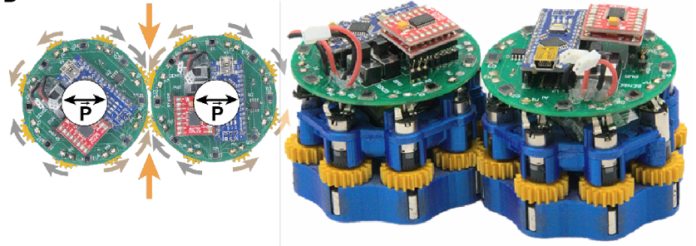Researchers at UC Santa Barbara and TU Dresden have engineered a proof-of-concept where a group of small, disk-shaped autonomous robots work together much like living tissue. These robots, which resemble tiny hockey pucks, are designed to join forces and assemble into different formations that exhibit distinct material qualities.
Inspired by biological systems, the project focuses on creating a robotic assembly that can be both robust and flexible. The goal is for the robots not just to adopt a specific form in response to external forces, but to be internally programmed to reshape themselves on demand. In living embryos, cells self-organize, heal, and transition between fluid and solid states—a process guided by internal forces, chemical signals, and adhesion. The team emulated these processes in their robots.
In the robotic system, eight motorized gears along each robot’s edge allow them to push, move, and reorient relative to one another, similar to how cells interact. Instead of chemical signals, light sensors with polarized filters act as a guiding mechanism, letting the robots “know” which way to adjust when exposed to a uniform light source. Magnets along their edges serve as the adhesive component, ensuring that once connected, the units stick together.
A key finding was the importance of signal fluctuations—variations in the commands sent to the robots—which enabled the collective to transition from a rigid, tightly packed structure to a more fluid state. This modulation not only facilitates reconfiguration and self-healing but also does so using less power compared to constant force application.
While the current demonstration involves 20 larger robots, simulations suggest that this concept could be expanded to a larger number of miniaturized units, making the system even more similar to naturally occurring materials. Beyond advancing robotics, this research provides a new platform for exploring active matter phase transitions and could inform biological studies on tissue mechanics.





